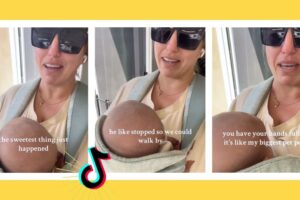
The Human Milk Banking Association of North America (HMBANA) has been working with donors to deliver life-saving pasteurized donor human milk to babies in need in the neonatal intensive care unit (NICU) since 1985. There are now 31 member nonprofit milk banks, including 28 across the US and three in Canada.
HMBANA’s nonprofit milk banks offer a lifeline to premature and medically fragile infants across the US, yet most families do not know that donor milk is available, safe and medically necessary for infants in the NICU.
As a mom who was only offered formula in the hospital and later learned about the importance of breast milk, especially for preterm babies, I knew more needed to be done.
There’s a knowledge gap when it comes to donor milk: Milk banks need more donor milk to serve hospitalized infants, and parents need information on the benefits of using donor milk when parents’ own milk is not available. Parents with healthy infants and a healthy milk supply need to know how important donation is and how they can donate their milk.
A growing shortage in donor milk
So many of the first blood transfusions took place on historic battlefields, and later in hospitals to save men and women closest to death. Human milk banking and use of donor milk throughout NICUs is not dissimilar. Pediatric doctors, nurses, and NICU parents know that NICUs often feel more like a battlefield than a health care setting as they watch the tiniest, most fragile babies and their families fight with everything they have to take a single breath and make it through another night.
The US is currently facing a significant and growing milk shortage. Hospitals need an estimated 160,000 additional ounces of donor milk to ensure the safest care for vulnerable NICU babies across the country. While 160,000 ounces seems overwhelming, it is important to keep in mind that number breaks down to less than 16,000 donors.
Ceres Chill is working with HMBANA Milk Banks to increase milk donation and close that gap.


Access to donor milk saves lives
While a simple Google search will tell you how important breastmilk is for the growth and health of babies, many of us still don’t grasp how vital and lifesaving it is for premature and hospitalized infants. For babies in the NICU, who are at a higher risk of disease and complications, it’s a life-saving resource. Every day in the US, one baby dies from necrotizing enterocolitis (NEC), a devastating intestinal disease that is a leading cause of death in premature infants. Access to donor milk can change that because breast milk offers protection against NEC.
“The chances of developing this deadly condition, along with many others, are greatly reduced when breast milk is available to these babies,” says Paula Norcott, IBCLC and member of the Ceres Chill Science Advisory Board. “We’re dealing with a life-or-death situation.”
The risk of developing NEC is up to 10 times lower for premature babies who are fed breast milk, compared to those who are formula-fed.
Moms of infants in the NICU often face challenges related to milk supply due to preterm birth complications, stress, physical separation from their newborn, and lack of support. Access to donor milk is crucial for NICU families, but we need to ensure hospitals provide this life-saving intervention and milk banks have enough milk to keep up with the increasing demands.
How to take action
We all can help give premature infants the chance to thrive by valuing the life-saving power of human milk. Meaningful action can start by recognizing the power of donors, the impact they have and the needs of so many infants in intensive care.
Get loud: By sharing stories in our community and on social media, we can do our part to spread the word about the importance of donor milk and normalize its use. Before giving birth or when choosing a hospital, we should ask about the availability of donor milk and the circumstances when it is offered.


Give the gift of time or money: HMBANA milk banks are nonprofit organizations and have significant operating costs to ensure all of the donor milk is safe and accessible to infants in need. If you are not able to donate milk, donating your time or funds toward their mission is another way to make a real difference.
Consider donating breast milk: Finally, becoming a milk donor is one of the most generous actions you can take. Most milk banks require donors give 100 ounces or more, but keep in mind that milk banks accept donor milk that has been frozen for up to eight months. That’s less than half an ounce a day!


Tragically, some infants, such as those requiring intensive care, do not survive. With broken hearts and empty arms, bereaved mothers may find peace in milk donation. One such mother, Jennifer Canvasser, founder and executive director of the NEC Society, lost her son, Micah, to complications of NEC just before his first birthday. Determined to honor her son, Jennifer donated thousands of ounces of Micah’s milk to three HMBANA Milk Banks. For bereaved mothers, like Jennifer, HMBANA Milk Banks do not require a minimum ounce donation.




How to get started with donating breast milk


Interested in donating breast milk? Follow these simple steps.
First, check out this map and find a location close to you or one that you want to send your milk to.
Then, participate in a brief interview and fill out the related form: sharing more details about your medical history and lifestyle, as well as signing medical consent forms.
Finally, take the blood test. The last step in the screening process is to complete blood work. You will be screened for HIV, HTLV, hepatitis B and C, and syphilis. The milk bank will coordinate and pay for your blood work.
*Important information to know: some milk banks will pick up your milk at your house, or even at a hotel or airport if you are traveling. All HMBANA milk banks will cover your costs for the blood test and shipping, and some will even send you what you need to mail your milk to the bank.
Exceptions to note
Milk banks and NICUs maintain specific guidelines for donor milk to ensure optimal nutrition and safety for premature and medically fragile infants. While all breast milk has value, NICU donations require additional screening criteria to meet the unique needs of these vulnerable babies. Milk that doesn’t meet NICU-specific requirements can still provide incredible benefits in other donation contexts.
Some circumstances that prevent milk banks from using milk donations for infant feeding include:
- Medical history: Having a positive blood test result for HIV, HTLV, Hepatitis B or C, or syphilis
- Medications: While many medications are compatible with milk donation, some are not. Of note, high blood pressure medications are not compatible with milk donation.
- Substance use: Smoking, significant alcohol consumption, using tobacco products, or using illegal recreational drugs
- Blood transfusions: Receiving a blood transfusion or blood products in the four months preceding the expressed milk offered for donation
- Organ or tissue transplants: Receiving an organ or tissue transplant in the 12 months preceding the expressed milk offered for donation
That said, milk banks do everything they can to ensure every drop of milk goes toward protecting infants and improving NICU care. For instance, UC Milk Bank uses donated milk that cannot be sent to hospitals for groundbreaking research through the Human Milk Institute.


The bottom line: You can save lives
Here are some key things to remember when starting your donor journey:
There are so many ways to donate milk after being registered in the HMBANA system.
- If you’re traveling and unable to safely store and bring extra milk with you, you can donate to any local milk bank with a simple call to transfer over your information. Some milk banks will even pick your milk up at the airport. As a mom who dumped thousands of ounces down the drain during work trips, I wish I had known about this option.
- If you have milk in the freezer that’s less than 8 months old, you can donate at least 100 ounces to a HMBANA milk bank.
- All HMBANA milk banks will cover your costs for the blood test and shipping, and some will even send you what you need to mail your milk over to the bank.
- And finally, whether you’re donating milk or helping to spread the word about the need for donor milk, you are SAVING LIVES. That is something to be incredibly proud of!
- If you’re a current donor or you’re going through the registration process, we want to support you and give you the tools to pump, store and donate your milk with pride and without worry. Check out Ceres Chill’s Human Milk Saves Lives Initiative to see how we can support you.
Together, we can ensure all babies have the human milk they need to thrive.
This story is a part of The Motherly Collective contributor network where we showcase the stories, experiences and advice from brands, writers and experts who want to share their perspective with our community. We believe that there is no single story of motherhood, and that every mother’s journey is unique. By amplifying each mother’s experience and offering expert-driven content, we can support, inform and inspire each other on this incredible journey. If you’re interested in contributing to The Motherly Collective please click here.




